ARCHIVED FROM: http://thosewhocansee.blogspot.com/2016/07/why-do-progressives-get-religion_40.html
Please read there for updates. I save these because I can’t tolerate them disappearing.
Why Do Progressives Get Religion?

Toronto Children’s Choir welcomes Arab refugees, December 2015
(Part II*of two)*
We recently took up John McWhorter’s assertion that Anti-Racism / Multiculturalism has become a religion. We found many ways in which the argument holds up–clear evidence of dogma, holy writ, acts of piety, fighting heresy, etc.
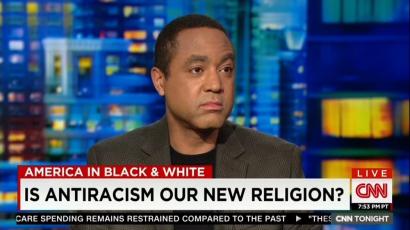
But a deeper question is, Why? What isit about the progressive mind that makes it so vulnerable to this type of extreme out-group empathy?
The proposed reasons are many. Today we offer up a selection that may help us better grasp what we’re dealing with when faced with a fervent Multiculturalist who seems immune to all fact and logic.
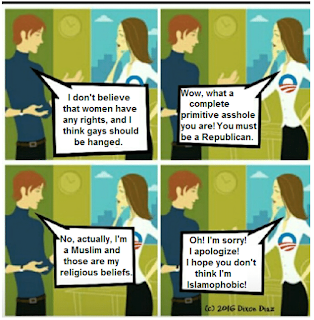
Out-group empathy gone haywire
- Why We’veAll Got this Religion
Before we talk about progressives in particular, let’s look at us WEIRDs in general (Western, Educated, Industrialized, Rich, Democratic). (Or WEIRDOs, if one adds ‘Outbred.’)
A hundred years ago, prominent leftists like J.A. Hobson could speak of the ‘backward races’ or the ‘non-adult races’ without anyone batting an eye. Today not even the rightest of the right-wing could utter such a phrase without being pilloried. As this Overton window shift testifies, today’s Anglo-Germanics have become far more open to outsiders than pretty much anyone in human history.

Conservative actor Nick Searcy
Why is this so?
(Our apologies, some of this has been posted before.)
1) Our natural environment

Our hunter-gatherer past: To be in the out-group meant instant death
Let’s go back as far as we can. It cannot be stressed enough that out-group enmity isthe historical norm in all populations. We come from small hunter-gatherer groups; our oldest and deepest instincts are ‘trust closest family; be ready to kill all others.’ (Rushton,Diamond) As E.O. Wilson says, ‘the selection pressures of hunter-gatherer existence have persisted for over 99% of human genetic evolution.’ This is our common genetic heritage.
So how did we get from ‘kill all outsiders’ to ‘welcome all outsiders’ and, why not, even ‘let them kill us‘? The long path to our pathologically high-trust present is still a mystery. Some possibilities:
- a) ColdWinters Theory
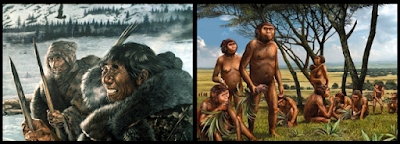
Did our ancestors’ environments determine our propensity to cooperate with others? (ImageSources)
Different theories on the question have been put forward by HBD thinkers. Most well-known is Richard Lynn’s ‘Cold Winters theory’, which was taken up by Edward Miller as ‘Parental Investment’:
In cold climates males were selected for provisioning, rather than for mating success. … Negroids (blacks) evolved in warm climates, while Caucasians (whites) and Mongoloids (Asians) evolved in colder climates. Mating is assisted by a strong sex drive, aggression, dominance, sociability, extraversion,impulsiveness, sensation seeking, and high testosterone. Provisioning is assisted by anxiety**, altruism, empathy**, behavioral restraint, gratification delay, and a long life span.
- b)Hunting-Gathering to Agriculture
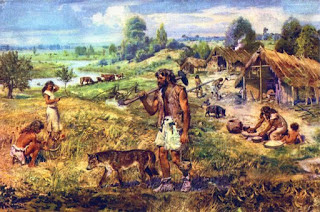
From hunting to farming: The Great Pacification?
Many researchers believe the very first large farming settlements (of which there is evidence going back to at least 7500 B.C.) were probably violent places, and that the first social controls mandating out-group cooperation were born here. Cochran and Harpending:
Farming led to elites, and there was no avoiding their power. … The old-style, independent-minded personalities that had worked well among hunter-gatherers were obsolete. … Since the elites were in a very real sense raising peasants, just as peasants raised cows,there must have been a tendency for them to cull individuals who were more aggressive than average, which over time would have changed the frequency of those alleles that induced such aggressiveness. (1)

Rubbing elbows with strangers for the first time: Catalhuyuk settlement (Turkey), 7500-5700 B.C.
- c**)Highland herders vs. Lowland farmers**

Tsaatan reindeer herders of Mongolia
Male combativeness is especially strong in highland pastoral societies beyond the reach of State control. … If highland pastoral societies represent one end of this behavioral continuum, the other end seems to be the low-lying farming societies of east and southeast Asia, where State formation, rice farming, and sedentary life favoredcollectivism over individualism and a general pacification of social relations.
(See also HBD Chick, Flatlanders vs. Mountaineers.)
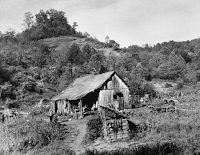
David H. Fisher in Albion’s Seed talks about settlers from the violent, arid border regions of Scotland and England in our southern back country:
The people of this region were intensely resistant to change and suspicious of “foreigners.” One student of the Appalachian dialect found that “the word foreigner itself is used here [in Appalachia] in its Elizabethan sense of someone who is the same nationality as the speaker, but not from the speaker’s immediate area.” All the world seemed foreign to the backsettlers except their neighbors and kin. … (2)
Nisbett and Cohen, in Culture of Honor**, also argue that in the southern U.S. the ‘honor culture’ and suspicion of outsiders still persists today, as seen in the customs, behaviors, and crime rates of the U.S. South’s Euro population. (3)

Herding camels in India,**llamas & alpacas in Peru, yaks in the Himalayas
2) Cultural pressures
We have seen that our natural environment has perhaps shaped our attitude towards out-groups in various ways. But what about cultural pressures?
a) Family formation
Outbreeding
Cousin marriage was once the norm in most places; today it has died out in much of the world:
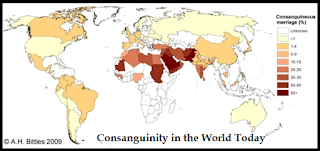
Steve Sailer, in his 2003 ‘The Cousin Marriage Conundrum,’ was the first journalist to succintly point out the problems of societal trust where cousin-marriage is prominent:
By fostering intense family loyalties and strong nepotistic urges, inbreeding makes the development of civil society more difficult. … Extended families that are incredibly tightly bound are really the enemy of civil society because the alliances of family override any consideration of fairness to people in the larger society.

From HBD Chick, ‘Tribes and types of cousin marriage’
No one has done more to try to pick apart the biological ‘why’ of high- and low-trust peoples than HBD Chick. Her online research on the history of cousin-marriage is unmatched. (Consult her blog for a wealth of data on consanguinity around the world; see also JayMan’s detailed sum-up.) As she has shown, while Muslims favored inbreeding, the early Church pushed outbreeding.
According to her theory, the most familistic, out-group-wary peoples on the planet today are those with the longest histories of inbreeding, and the high-commonweal folks are those who stamped out cousin marriage first–notably NW Europeans. (See also JayMan.)
Manorialism
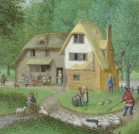
Many have noted that Latins and especially Slavs appear less outgroup-welcoming than Anglo-Germanics. Drawing on Mitterauer, Todd, Clark, and others, HBD Chick has argued that the Germanic ‘core’ of Northern Europe (inside the Hajnal line) underwent a series of unusual selection pressures (see her outstanding piece here, alsoJayMan and Peter Frost). Among them were manorialism:

Early manorialism and modern corruption inside the Hajnal Line (HBD Chick)
In the bipartite manor system, peasants or serfs … lived on and managed their own farms (let out to them by the manor owner) and also worked on the manor or paid rent to the manor. Extended families very much did not fit into the manor system as it operated in Western Europe.So manorialism — at least western manorialism — “pushed” for the nuclear family.
This system seems to have fostered individualism, commonweal-orientation, civicness, less violence–and, who knows, the seeds of our extreme out-group empathy?
b) Printing press

Cultural pressures can come from new technologies as well. For Steven Pinker, the ‘better angels of our nature’ have pushed us to be more out-group friendly, first and foremost due to mass literacy:
The growth of writing and literacy strikes me as the best candidate for an exogenous change that helped set off the Humanitarian Revolution. … Reading is a technology for perspective-taking. When someone else’s thoughts are in your head, you are observing the world from that person’s vantage point. … you have stepped inside that person’s mind and are temporarily sharing his or her attitudes and reactions.
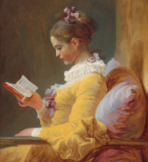
Did novel-reading turn us empathetic?
… Around the same time that Uncle Tom’s Cabin mobilized abolitionist sentiment in the United States, Charles Dickens’s Oliver Twist (1838) and Nicholas Nickleby (1839) opened people’s eyes to the mistreatment of children in British workhouses and orphanages, and Richard Henry Dana’s Two Years Before the Mast: A Personal Narrative of Life at Sea (1840) and Herman Melville’s White Jacket helped end the flogging of sailors. (5)

Personality blogger Staffan is skeptical:
I believe that the people [John] Locke and others addressed were already equipped with a wide capacity for empathy. When they heard of other people around the world and the arguments on how they should be treated, they responded accordingly…
Staffan’s major beef with Pinker:
…**Width of empathy is only large in Northwest Europeans and their descendants.**People sometimes referred to as WEIRD (Western, Educated, Industrialized, Rich, Democratic). … The rest of the world is not very impressed by Enlightenment ideals and it never was.
- c) Urban vs. Rural
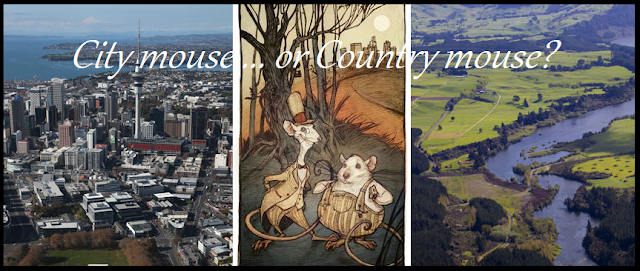
More city mice than ever before?
Another cultural pressure is that of dense urban vs. loose rural living. As noted above, Cochran and Harpending surmised that the first large settlements of 10,000 years ago likely tamed our fiercest out-group murderousness.
The ‘city mouse / country mouse spat’ is in any case as old as recorded history. From Aesop’s fable, after Country Mouse feasts in town with his City Cousin and is attacked by cats and dogs:
The Country Mouse said, “No, no; I shall be off as fast as I can.I would rather have a crust with peace and quietness, than all your fine things in the midst of such alarms and frights as these.”

‘Rather a crust with peace and quiet’
For millennia the peasant has been mocked as a hidebound simpleton, the city-dweller as an effete dandy. (Not without reason.) But the Romes and Baghdads were the exception– for most of the last 10,000 years, we’ve been 95% rural-dwellers. Only today, post-Industrial Revolution, has that ratio nearly reversed itself.
Voting patterns show that city folk tend to vote left and country folk right (click to enlarge):
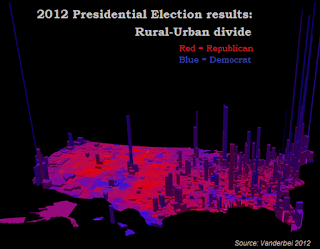
So do cities turn people liberal, or are liberals drawn to live in cities? According to Pew, it’s the latter:
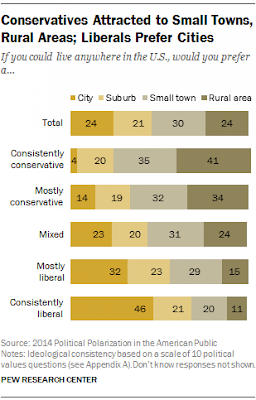
But this can be a chicken-and-egg question: Are conservatives drawn to the countryside and liberals to the city because that’s where they perceive others like themselves to be? Does growing up in a city–which more of us do now then at any time in history– push people to more out-group tolerance? Since we were 95% rural folk for most of history, but are today less than 20%…
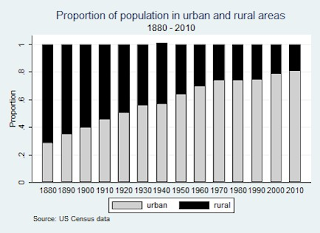
…could this new way of living be pushing us to a ‘bigger circle of empathy’?
- d) Wealth
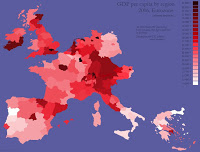
GDP per capita, Eurozone (pre-crisis)
Can greater wealth itself become a cultural pressure? Ronald Inglehart of the World Values Survey thinks so. He claims that in general, as a people grows wealthier, it becomes more out-group tolerant:
[Economic] development is linked with a syndrome of predictable changes away from absolute social norms, toward increasingly rational, tolerant, trusting, and postmodern values. But culture is path dependent. The fact that a society was historically Protestant or Orthodox or Islamic or Confucian gives rise to cultural zones with highly distinctive value systems that persist when we control for the effects of economic development. (6)
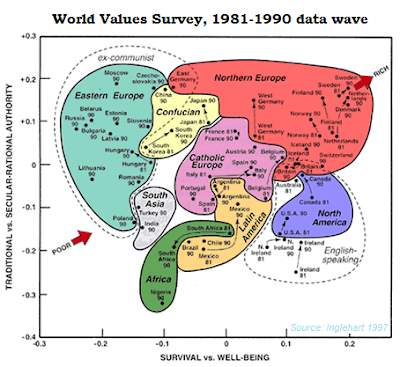
Image source: WVS**(click to enlarge)
Inglehart was the first to place the world’s countries on a scatter plot according to two value axes: “traditional <–> secular” and “survival <–> self-expression”:
TRADITIONAL / SECULAR
… Societies at the traditional pole emphasize religion, absolute standards, and traditional family values; favor large families; reject divorce; and take a pro-life stance on abortion, euthanasia, and suicide. They emphasize social conformity rather than individualistic achievement, favor consensus rather than open political conflict, support deference to authority, and have high levels of national pride and a nationalistic outlook. (Societies with secular-rational values have the opposite preferences on all these topics.)
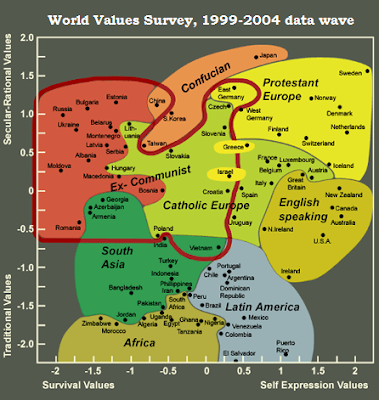
Image source: WVS**(click to enlarge)
SURVIVAL / SELF-EXPRESSION
Societies that emphasize survival values show relatively low levels of subjective well-being, report relatively poor health,are low on interpersonal trust, are relatively intolerant toward outgroups, are low on support for gender equality, emphasize materialist values, have relatively high levels of faith in science and technology, are relatively low on environmental activism, and are relatively favorable to authoritarian government. (Societies that emphasize self-expression values tend to have the opposite preferences on all these topics.) (6)
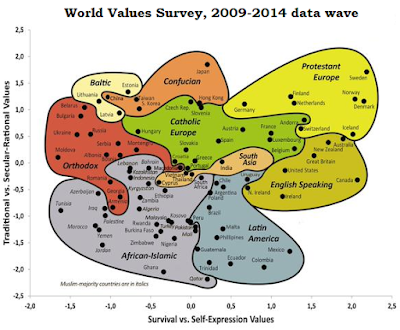
Image source: WVS**(click to enlarge)
Extensive evidence indicates that these values tap an intergenerational shift from emphasis on economic and physical security toward increasing emphasis on self-expression, subjective well-being, and quality of life … it seems to emerge amongbirth cohorts that have grown up under conditions in which survival is taken for granted.
These generations ‘free from all want’ are quite new, and are mostly found in the West. Could this help explain our current crop of hothouse flowers, so blithely trusting of outsiders?
3) Group Pressures
In addition to our natural environment and cultural pressures, many feel that certain groups have had an outsized effect on our level of empathy to outsiders.
- a) Women
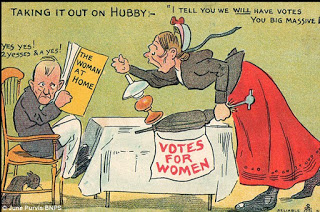
Suffragettes, target of mockery
In the West, the industrial revolution led to countless changes, including that of the rise of women as a ‘lobby.’ Some warned of trouble ahead. Author Madeleine V. Dahlgren, in 1871:
The special advantage as a safe advisor to man that woman holds at present arises entirely from the neutral ground she occupies in the political world. Were she herself to enter the arena her ardent impulses would lead her to the most dangerous experiments. The fact is, women reason less and feel more deeply than men.
… Involved in one common ruin from our present proud preeminence, [after women’s suffrage] we shall become a laughing-stock and a by-word to the nations of the world.
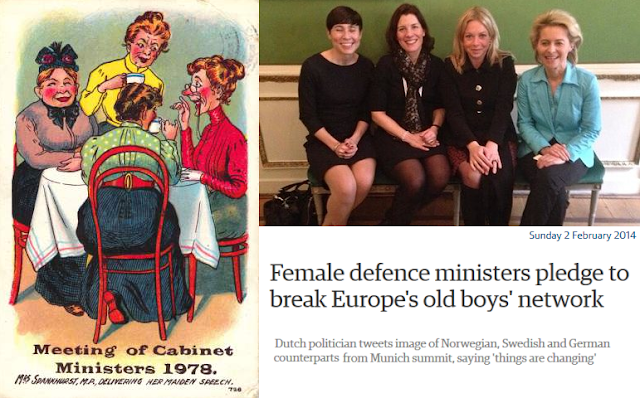
Turn-of-the-century cartoonist no doubt thought his prediction was pure comedy
Addressing the Mont Pelerin Society 30 years ago, Wellesley’s Brigitte Berger aptly predicted the feminization to come:
The general acceptance of the feminist definition of private and public life in the Western democracies as the new orthodoxy, in conjunction with the prescriptive thrust of feminism, result in the feminization of politics, the feminization of the economy and the feminization of the culture. Taken together we may thus speak of the ascent of a new sentimental imperialism.
(The ‘old sentimental imperialism’ is well laid out in Chapter 3 of Hobson’s 1905 Imperialism, A Study. Our work on the subject can be found here.)

This is carried, in the main, by the feminist vision that seeks to radically transform world culture. This general imperialistic thrust of feminism … will decisively shape the direction of future public debates.
In the words of Gloria Steinem “…we can humanize the machinery of politics to make a better society.” Said Betty Walker Smith, “Let’s humanize America and save her.” … These pioneer voices of 1970s feminist activists have become familiar bromides today:instead of women having to become more like men, men will have to become more like women.

The Zeroeth Amendment (from Steve Sailer)
Men are supposed to be the hard-headed ones, women the soft-headed. Has this ‘feminization of politics’ led to what Steve Sailer calls ‘Invade the World, Invite the World’ (democratize the poor dears by force and if that doesn’t work, invite them all here) and ‘the Zeroeth Amendment’ (everyone on Planet Earth has the right to immigrate to the U.S.)?
It is impossible to say with surety that women’s entry into politics has led to more out-group friendly policies, but the evidence is intriguing.
- b) Catholics / Protestants

Traditional religions of Europe (click to enlarge)
We have seen that the early Church’s anti-inbreeding push changed family formation and thus values in Europe. Could the later influence of the Protestant and Catholic churches have affected our out-group feelings as well? Or is that the cart before the horse– are the out-group tolerant more likely to become Protestant in the first place? Inglehart:
… As the figure demonstrates,virtually all historically Protestant societies rank higher on interpersonal trust than virtually all historically Catholic societies. This holds true even when we control for levels of economic development: interpersonal trust is significantly correlated with the society’s level of GNP/capita, but even rich Catholic societies rank lower than equally prosperous historically Protestant societies. (6)
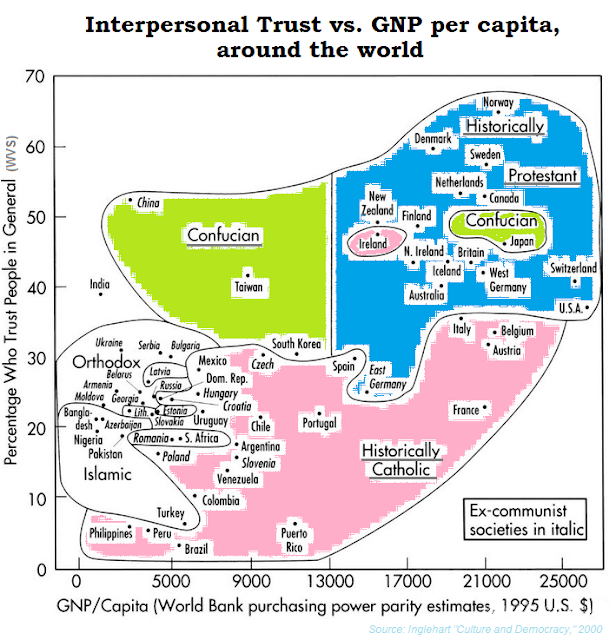
Paul Gottfried also posited a Protestant connection in Multiculturalism and the Politics of Guilt:
Even relatively tolerant Anglo-American peoples until recently did not behave with deference toward those recently arrived and culturally alien. … The desperate efforts now being made by Western countries, particularly by Protestant ones, to raise themselves morally by receiving populations entirely “distinct” from themselves is not a continuation of older attitudes toward immigration.
… Without the guilt ethic preached by contemporary Christianity, it would be hard to imagine the sweeping affirmations now taking place about the moral superiority of alien cultures. (10)
- c) Communists
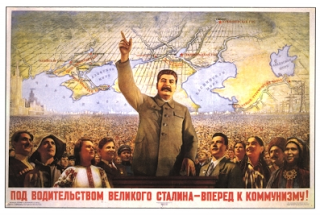
What about the influence that communist government–or lack of one–can have? Inglehart:
A heritage of communist rule also seems to have an impact on this variable, with virtually all ex-communist societies ranking relatively low. Accordingly, historically Protestant societies that experienced communist rule, such as East Germany and Latvia, show relatively low levels of interpersonal trust. (6)
He is referring to the graph just above, but here is a more recent WVS meausure of societal trust vs. corruption around the world–note Eastern European countries in light blue:
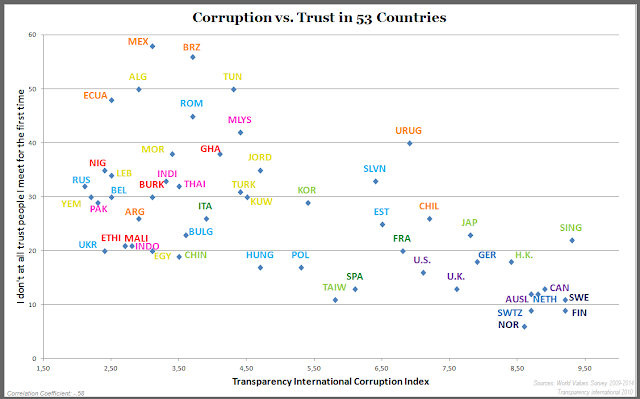
Data source 1**, source 2 (click image to enlarge)

But this too becomes chicken-and-egg—How many countries adopted communism because it was congenial to their character, versus having it thrust upon them by outsiders?
Whatever the cause, during the recent Merkel-imposed immivasion, the old Eastern Bloc countries have shown themselves strangely immune to the siren song of Multicultism.
- d) Academics
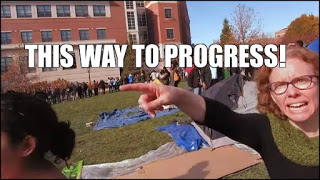
Many complain that academia has taken a big role in pushing for ever more out-group tolerance:
During the past quarter-century, academia has seen a nearly 20-percent jump in the number of professors who identify as liberal. That increase has created a lopsided ideological spread in higher education, with liberal professors now outpacing their conservative counterparts by a ratio of roughly 5 to 1.
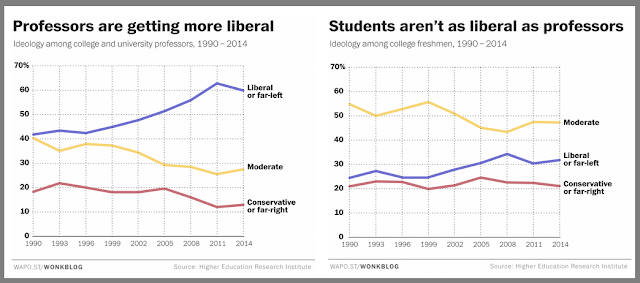
Image source (click to enlarge)
Slightly older data shows college professor to be the most liberal profession out there:
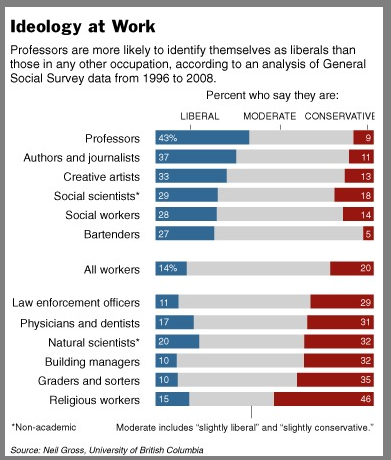
Thirty years ago in his Closing of the American Mind, Allan Bloom was sounding the alarm on college indoctrination:
So indiscriminateness is a moral imperative because its opposite is discrimination. This folly means that men are not permitted to seek for the natural human good … Instinct and intellect must be suppressed by education.
He warned about being too pliant with out-groups:

That dominant majority gave the country a dominant culture with its traditions, its literature, its tastes, its special claim to know and supervise the language, and its Protestant religions. Much of the intellectual machinery of twentieth-century American political thought and social science was constructed for the purposes of making an assault on that majority… in favor of a nation of minorities and groups each following its own beliefs and inclinations.
… None of this concerns those who promote the new curriculum. The point is to propagandize acceptance of different ways … Practically all that young Americans have today is an **insubstantial awareness that there are many cultures,**accompanied by a saccharine moral drawn from that awareness:We should all get along. Why fight? (7)
Bloom himself probably couldn’t have imagined how far this snowball would roll:

Campus out-group obsequiousness?
- e) Jews
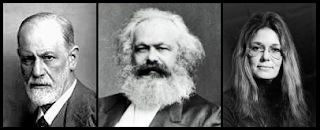
Though today the notion has become dangerously unfashionable, one cannot deny the outsized influence the Jewish diaspora has had on multiculturalism in the West. Evolutionary psychologist Kevin MacDonald:
Studies in Prejudice and, especially, The Authoritarian Personality attempt to show that gentile group affiliations, and particularly membership in Christian religious sects, gentile nationalism, and close family relationships, are an indication of psychiatric disorder. At a deep level the work of the Frankfurt School is addressed to altering Western societies in an attempt to make them resistant to anti-Semitism by pathologizing gentile group affiliations.
A consistent theme of The Authoritarian Personality is the idea that gentile participation in cohesive groups with high levels of social conformity is pathological, whereas similar behavior of Jews … is ignored.

A common component of anti-Semitism among academics during the Weimar period was a perception that Jews attempted to undermine patriotic commitment and social cohesion of society. (8)

This list of environmental as well as cultural pressures has, we hope, helped to give some clues as to how the Overton window could have shifted so far left on questions involving out-groups (segregation, immigration, interracial marriage / adoption, etc). Put simply, allethnic NW Euros today–right and left–have a historically unprecedented level of out-group empathy.
So now we come to the real object of our study: the dyed-in-the-wool leftist. As we have seen, he has been gripped devilishly hard by the The Anti-racist / Multiculturalist fervor.
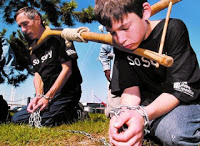
But why? What is it about his worldview that makes him so vulnerable to this kind of dogmatism?
- Why Progressives Are the Most Zealous
Stephen Pinker in his 2002 classic The Blank Slate laid out the differences between (among others) male and female brains.
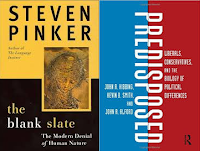
In their 2013 Predisposed: Liberals, Conservatives, and the Biology of Political Differences, Hibbing, Alford, and Smith have done the same for liberals and conservatives.
It may help us to sympathize a bit more with the fervent blank-slatist, as there’s a good chance he was, in fact, ‘born this way.’ What is the evidence?
1) Character traits
Hibbing et al. found evidence that self-identified liberals and conservatives differ on a great deal more than just economic policy.
- a) Preferences
Via a variety of studies and online polls, they posit that there are real lefty and righty differences in (9):
- food preference (greens vs. meat)

-
humor preference (resolution of incongruity or not)
-
favorite fiction (ambiguity vs. clear resolution)
-
favorite art (abstract vs. representational)

Jackson Pollack, Nicolas Poussin
-
personal space orderliness (less vs. more)
-
car preference (Volvo vs. Porsche for rich, Japanese vs. American for poor)

Rich lefty, rich righty
- choice of investment stocks (high-tech vs. heavy industry)
- b) Values
Via values studies, Hibbing et al. find even more variation in the personality of righties and lefties.
We here at TWCSare peering into the liberal mind. But as Hibbing et al. point out, since the age of the great totalitarianisms, most researchers have been trying to pin down the supposed right-wing ‘authoritarian personality.’ Theodor Adorno (cited above) wrote the best-known work on this elusive ‘authoritarian’ who walks among us.

Researchers have tried to tease out this creature via scales: Adorno’s colleague Frenkel-Brunswick and her ‘F-scale’ (for ‘fascism’), Glenn Wilson and his ‘C-scale‘ (‘conservatism’), Robert Altemeyer and his ‘RWA‘ (‘right-wing authoritarian’ index). Hibbings et al. bemoan the fact that the left-wingauthoritarian personality has been so little studied, with Hans Eysenck the only one venturing down this path. (9)
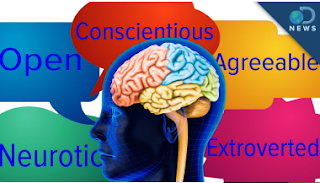
Other values scales may be more familiar to us:
-
The ‘Big 5’ from Goldberg and Costa & McCrae (Openness / Conscientiousness / Extraversion / Agreeableness / Neuroticism),
-
‘HEXACO’ from Ashton & Lee (Honesty-Humility / Emotionality / Extraversion / Agreeableness / Conscientiousness / Openness), and
-
Haidt and Graham’s ‘Moral Foundations’ theory (Harm / Fairness / Loyalty / Authority / Purity).
For the Big 5, left-wing voting is associated with high Openness, right-wing voting with high Conscientiousness.
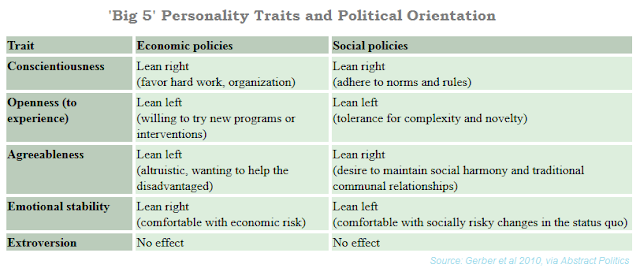
(You can see where you fall on the Big 5 traits here.)
For Haidt’s ‘Moral Foundations’ theory, concern about Harm and Fairness are associated with voting left; concern about Purity, Loyalty, and Authority with voting right:
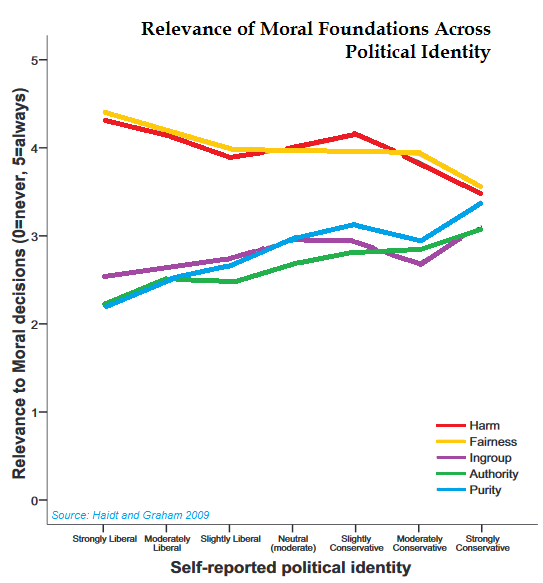
(You can see where you fall on Haidt’s ‘moral foundations’ here.)
*(A study on HEXACO and politics can be found here**; see also JayMan’s work*on HEXACO.)
In a nutshell, then, personality studies seem to line up well with voting–one may almost speak of a leftist and rightist personality ‘type.’
2) Lab studies
Cultural preferences and personality traits aren’t the only ways in which lefty and righty minds seem to differ. Once in the lab, things become even starker.
Via a variety of lab tests, Hibbing et al. show lefty and righty differences in:
- Ability to taste PTC (compound giving bitter taste to veggies such as arugula)

Arugula again
-
Ability to smell androstenone / finding its smell pleasant (linked to testosterone) (more accepting of social hierarchies–righty)
-
Being affected by gaze cues

Our findings suggest that liberals are more influenced by social cues—even when told to explicitly ignore those cues. Conservatives seem to be more willing or able to ignore cues and follow the rules that govern the situation. … We found that conservatives were more likely to believe it is “better” for people not to be influenced by where others are looking, while liberals were just the opposite. (9)
-
Placing objects in categories (e.g. zoo vs farm animals–righties are ‘hard’ and lefties ‘soft’ categorizers)
-
Signaling negative words (Stroop task) (righties focus longer on them)
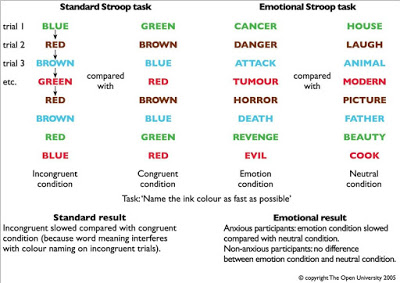
- Focusing the gaze on disgusting images (righties focus longer on them)
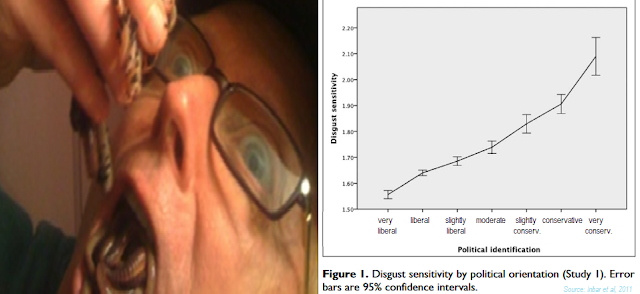
If you’re conservative, you jumped slightly higher than a liberal at this
-
Looking at angry faces
-
Looking at ambiguous faces (righties more likely to interpret all faces negatively)
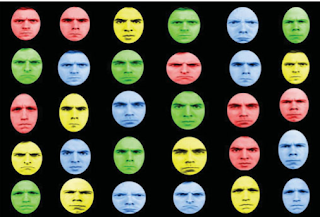
We even interpret faces differently
- Picking ‘good’ and ‘bad’ beans in the game BeanFest
Not to go too into detail (see study), but a lab game called ‘BeanFest’ showed big variance in lefty and righty thought. Beans with different spots pop up, some add points, some subtract points. You have to suss out which are which, and remember for when they flash on the screen again.
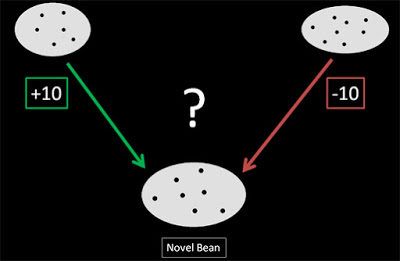
(You can play BeanFest here.)
It did not take long for the researchers to note that people varied widely in the way they played BeanFest. Some threw caution to the wind and accepted beans with abandon. This meant they gained and lost a lot of points but also collected substantial amounts of information about the value of the various beans. Others were much more wary, accepting just a few beans at first and then only accepting subsequent beans that matched the few types known to be good.
(One guess as to which political orientation was which.) After the game, the players were given a test to see what they’d retained:
Liberals were just a bit better at remembering which beans were bad than they were at remembering which beans were good; however, there was no such approximate balance for conservatives—they knew a bad bean when they saw one. Actually, they knew a bad bean even when they didn’t see one. Conservatives were way better than liberals at correctly identifying bad beans, but they were also more likely to miscategorize good beans as bad. (9)
So this is our leftist: Curious, incautious, resists negativity, embraces the new and the ambiguous, even to his detriment? One begins to see a certain logic in his attraction to Multiculturalism.
Be that as it may, couldn’t these differences just as well come from nurture as nature? Isn’t all of this highly malleable?
3) Biological differences
As it turns out, looking into the body itself, one can see political differences in our very biology.

Twin studies going back to 1986 have shown likely genetic links to political beliefs. More recent studies, such as Hatemi and McDermott (2012), have tried to break down the nature and nurture of ideology.
In the following graph pink is identical twins, blue is fraternal. We see how closely the two types of twins’ political views sync up throughout life:
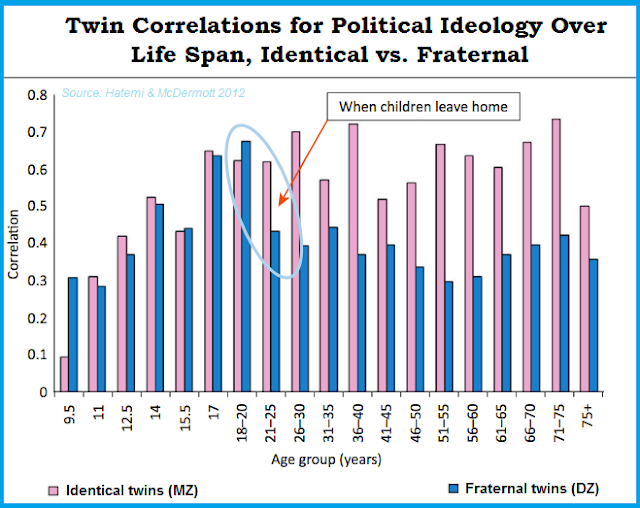
In this graph, based on 38 years of twin studies, the authors claim that ‘overall ideology’ (liberal-conservative) is almost 60% genetic (click to enlarge):
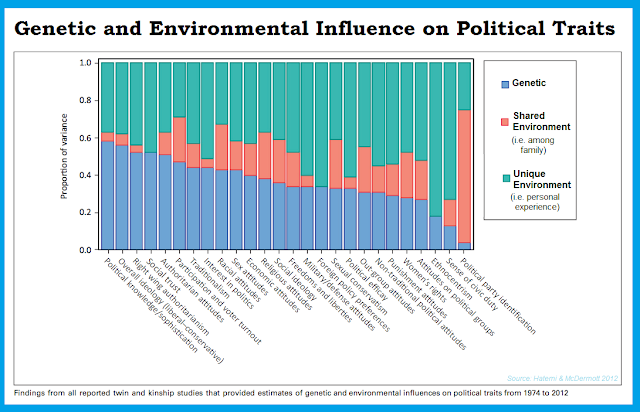
*(See also JayMan’s discussion*of Hatemi et al.’s 2010 paper.)
In *Predisposed,*based on various lab studies, Hibbing et al. find lefty and right differences in (9):
-
Size of anterior cingulate cortex (ACC) (smaller in righties)
-
Size of the amygdale (smaller in lefties)
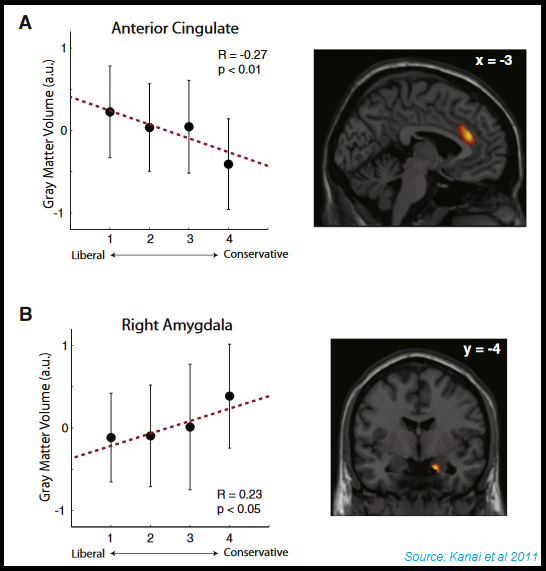
-
Electrodermal activity (EDA) in response to threatening or disgusting images
-
Our faces: Strangers can pick out lefty or righty faces

Can you pick out the righties and lefties?
- The DRD4 allele + a high number of friends affects one’s political orientation
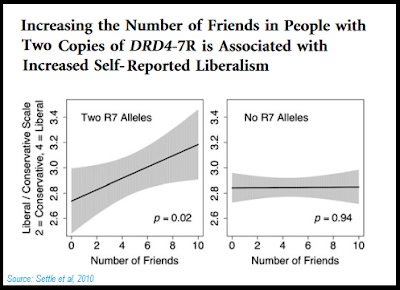
It is looking more and more like our affection for the outsider (or lack thereof) may have deep genetic roots.
* * *
After dissecting the leftist mind, Hibbing et al. try to explain these creatures to the conservative:
All this makes liberals far more trusting than they have any right to be, but it is important to realize that this is not because they are foolish or lazy but rather because they are structured in such a way that prevents them from appreciating the obvious dangers swirling about. …. Their first instinct is to assume individuals in faraway lands are trustworthy.

They love experiences that might take them off the beaten track. They seem not to look before they leap. … They don’t seem to consider, let alone mind, the fact that this openness raises the possibility that they could be taken in by evildoers. (9)
The authors also point to a likely genetic origin:
Our best guess is that in the rough and tumble of the Pleistocene, individuals who tried new things, opened themselves up to members of other tribes, and had little to no negativity bias were rare—it simply seems a losing long-term strategy in the face of all the dangers swirling about.

… Selection pressures in such environments would likelyfavor individuals with higher degrees of negativity bias, who approached novel situations with caution, who were loyal to their group, and who were suspicious of the tribe over the hill.
Our ultra-safe, coddled modern life has thus allowed that once-rare beast, the liberal, to be fruitful and multiply? Perhaps. (See*JayMan* on this.) They warn:
Liberalism may thus be viewed as an evolutionary luxury afforded by negative stimuli becoming less prevalent and less deadly. If the environment shifted back to the threat-filled atmosphere of the Pleistocene, positive selection for conservative orientations would reappear and, with sufficient time, become as prevalent as it was then. (9)
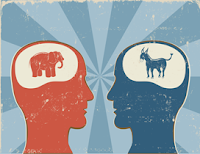
The question ‘Why are leftists so prone to Multicult fundamentalism?’, then, may have many answers. But we at TWCS feel the genetic aspect absolutely cannot be ignored. We would do well to keep this in mind at our moment of highest frustration:
Are we in fact trying to argue someone out of a belief which is simply a product of his own hard-wiring?
Religions wax and wane in strength. Ideologies, like fashions, come and go. Whatever its origin may be, let us hope that this particularly pernicious anti-racist faith loosens its grip on us before the body count grows any higher.
Thank you for reading.
Previously:
When Progressives Get Religion
REFERENCES
(1) Harpending, Henry and Cochran, Gregory, The 10,000 Year Explosion, NY: Basic Books, 2009.
(2) Fischer, David Hackett,Albion’s Seed, Oxford University Press, 1989.
(3) Nisbett, Richard and Cohen, Dov, Culture of Honor, Westview Press, 1996.
(4) Clark, Gregory,A Farewell to Alms, Princeton U. Press, 2009.
(5) Pinker, Steven, The Better Angels of our Nature, NY: Viking, 2011.
(6) Inglehart, Ronald, “Culture and Democracy,” in Harrison, Lawrence and Huntington, Samuel (editors), Culture Matters, NY: Basic Books, 2000
(7) Bloom, Allan, The Closing of the American Mind, NY: Simon & Schuster, 1987.
(8) MacDonald, Kevin, The Culture of Critique, First Books Library, 2002.
(9) Hibbing, John R.; Smith, Kevin B.; Alford, John R.,Predisposed: Liberals, Conservatives, and the Biology of Political Differences, Routledge, 2013.
(10) Gottfried, Paul E., Multiculturalism and the Politics of Guilt: Towards a Secular Theocracy, U. of Missouri Press, 2002.